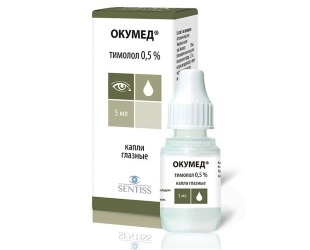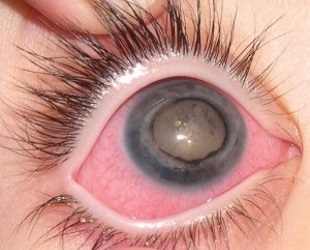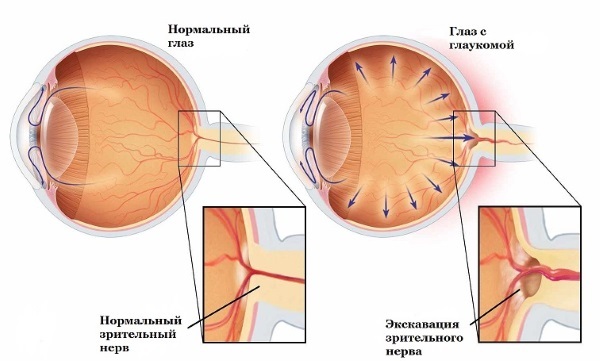
When dealing with a patient who has increased intraocular pressure, the ophthalmologist will in any case prescribe medications to lower it.
In modern medicine there is a wide range of drugs of similar action, but most of them are produced in the form of ophthalmic drops.
Okumed can be called one of the most common varieties of eye drops, which are most often prescribed by physicians to reduce intraocular pressure and the treatment of glaucoma.
- 1. Instructions for use
- 2. Side effects and contraindications
- 3. Conditions and periods of storage
- 4. Price
- 5. Analogues
- 6. Reviews
- 7. Conclusion
Instruction for use

Okumed isdrug, which belongs to the detachment of beta-blockers and has antiglaucoma effect.
Its use helps to reduce both increased and usual pressure inside the eyes, as well as to reduce the speed and volume of intraocular moisture production, without affecting the accommodation and pupil size.
Okumed quickly penetrates through the cornea and begins to work after
has passed twenty minutes after administration. The greatest effect of these drops is observed after one or two hours, and then continues throughout the day.Indications for use
Okumed is prescribed in such cases:
- Increased intraocular pressure or ophthalmic hypertension.
- Glaucoma is of an innate nature and secondary type.
- Open-angle glaucoma.
- In combination with miotics can be used for glaucoma of a closed-angle character.
Form release, composition
Okumed is produced in the form of ophthalmic drops of 0.25% and 0.5%, which is a clear liquid that does not have a color. One milliliter of these drops contains 2.5 milligrams and 5 milligrams of timolol maleate, respectively, as well as benzalkonium chloride, sodium hydrogen phosphate and dihydrogen phosphate, and injection water.
These drops can be found on sale in 5-ml and 10-ml plastic droppers, as well as in 5 ml glass bottles. This medicine is sold in a box of cardboard.
How to use
People aged over 10 years are usually prescribed one drop of 0.25% twice a day in the bag of the conjunctiva of the damaged eye, but in case of insufficient effect, 0.5% drops can be used in the same dosage.
The prophylactic dose when adjusting intraocular pressure to the norm should be one drop of 0.25% twice per day.
Persons up to ten years are prescribed one drop of 0.25% twice per day.
Okumed is suitable for regular use for an extended period.
Interaction with other
medications If digesting Okumed in parallel with drops containing epinephrine, it may cause an increase in the pupil. Reduction of pressure inside the vision organs occurs on a larger scale when the described drug is combined with drugs that include epinephrine and pilocarpine.
The use of Okumed in parallel with calcium blockers, reserpine and systemic beta-blockers often leads to a slowing of heart rate and a drop in blood pressure.
Do not combine Ocumed with insulin or oral medications to get rid of diabetes, as this can trigger the onset of hypoglycemia.
Described eye drops are not welcome at the same time as tranquilizers and antipsychotics, as well as alcoholic beverages, because this can lead to a severe decrease in blood pressure.
If the patient is to postpone surgery under general anesthesia, two days before his application of Okumed should be abandoned.

Side effects and contraindications
In the following table, we will disclose the side effects that may provoke the use of Okumed, as well as existing contraindications to the use of the drug.
| Side effects | Contraindications |
|
|
In the cases that will be listed below, Okumed should be used with with extreme caution :
- Pulmonary emphysema.
- Heart failure.
- Child's age.
- Severe cerebrovascular insufficiency.
- Sinoatrial block.
- Diabetes mellitus.
- Increased pressure.
- Thyroid dysfunction.
- Hypoglycemia.
- Reye syndrome.
- Myasthenia gravis.
- Use of other beta-blockers.
At pregnancy

As for today there are no data on possibility of application of described drops during gestational period they can be appointed to the pregnant woman by the attending physician only in the event that the benefit considerably exceeds risk.
In this case, it is necessary to take into account the property of timolol to penetrate through the barrier represented by the placenta.
Terms and Conditions of storage
Drops of Okumed should be kept out of reach for children and hidden from direct sunlight, a place where the air temperature does not rise above 25 degrees Celsius. Do not expose to frost.
The shelf life of Okumed is two years, but after printing it should be used for forty-five days.
Price
Average price in Russia
Inhabitants of the Russian Federation currently can purchase the described preparation for approximately 60 rubles .
Average price in Ukraine
In Ukrainian pharmacies, the approximate cost of Okumed drops is 48 hryvnia .
Analogues
The following medical preparations should be considered analogous to Okumed:
- Arutimol;
- Xalatan;
- Timolol;
- Travatane;
- Pilocarpine;
- ;
- Fotil ;
- Betoptik;
- Kosopt;
- of Azarga;
- Trusopter .
Reviews

The majority of patients in their reviews of Okmeda notes the high effectiveness of this drug in the treatment of both closed-angle and open-angle glaucoma.
They claim that these eye drops help lower the intraocular pressure within an hour after their administration.
Some patients noted that during the application of drops they had such unpleasant side effects as carvings and pain in the eyes.
If you want to see more detailed reviews of real people about Okumed, you will find them at the end of this article.
Conclusion
- Okumedom is a drug that is used in ophthalmic practice to reduce intraocular pressure and treat glaucoma.
- It is available in the form of drops.
- There are certain contraindications to the use of Okumed.
- During the waiting period for the child, this medication can only be prescribed at the most extreme.
- Sometimes the use of Okumed can trigger the occurrence of undesirable side effects.
- If necessary, Okumed can be replaced with one of the similar drugs, having discussed this possibility with a doctor beforehand.
- Okumed has an affordable price and enjoys a good reputation among patients.
